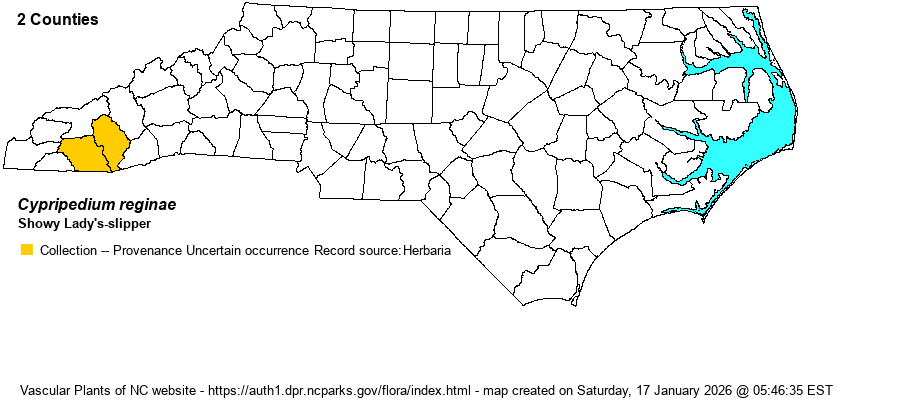| Author | Walter | |
| Distribution | This showy species might not be native in NC. There is one specimen at NCU, from Jackson County, considered by Weakley (2020) as an "implausible habitat". However, the specimen label as checked by B. Sorrie (one of the website editors) makes no mention of rhododendrons, which Weakley (2020) says was collected from "highly acid humus under rhododendron". A second record is from Macon County (PLANTS database), but the habitat is unknown. A photo on iNaturalist from Madison County in June 2023 is correctly identified (in bloom), but the provenance has been questioned there, as expected. Sorrie has seen Cypripedium reginae in MA on a couple of steep montane slopes (with hemlocks) where slumping has opened the canopy and exposed seepy, clayey soil. It is possible that the NC populations may have come from a similar habitat, though this species seems to require circumneutral soil in natural habitats elsewhere; rhododendrons characteristically grow in acidic soil. Weakley (2022) states that "Other rumors of occurrence in NC have not been substantiated" and thus he says that "The native occurrence of this species in NC is questionable". At any rate, the two records of specimens are from the southern Mountains, from many decades ago.
As expected, this is a Northern species, ranging widely across central and eastern Canada, south to NY and IA, and southward mainly in mountains. In the Appalachians, it ranges south to southwestern VA, northeastern TN, and the Ozarks of MO and AR. The NC locations are disjunct over 100 miles to the south. | |
| Abundance | Of historical occurrence, with records many decades old. Known for certain in NC from just two collections. Owing to concerns about the possibly acidic habitats, these could have been planted, though one might question why it would be planted under rhododendrons instead of some other places such as seepages or meadows. The NCNHP gives it a State Rank of SNA (State Not Applicable for conservation), and has removed any Watch List status (formerly W4 -- perhaps not native), implying a non-native status (SE). The website editors suggest SE?, and have shown the records on the maps as of Provenance Uncertain. | |
| Habitat | Over its range this is one of the few orchid species found primarily over high pH soils; most or nearly all others favor acidic soils. Habitats are mostly in damp ground, such as in fens, seepage areas, swamps, and moist spots in forests. RAB (1968) gives its NC habitats as "Swamps and mossy, wooded slopes" without mention of soil pH. | |
| Phenology | Blooms mainly in May in the southern part of the range; fruits in June and July. | |
| Identification | This is arguably the most beautiful wildflower in the eastern U.S. and Canada. It is a large orchid, growing to about 2-2.5 feet tall, with 3-8 large and erect to spreading leaves along the stem. The single flower, at times two flowers, is about 3-4 inches across and is strikingly white (sepals and petals), with broad and widely elliptical and rounded petals over a large pouch-like or slipper-like lip, which is rose-pink. As the flowers are so striking and can be seen from long distances, it is no surprise that the plants are highly prized by poachers taking them from the wild for planting in gardens and for other reasons. It cannot be confused with any other species when in flower. | |
| Taxonomic Comments | None
| |
| Other Common Name(s) | Queen Lady's-slipper, Pink-and-white Lady's-slipper | |
| State Rank | SE? | |
| Global Rank | G4G5 | |
| State Status | | |
| US Status | | |
| USACE-agcp | | |
| USACE-emp | FACW link |

